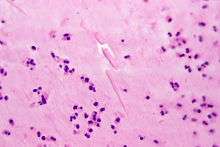Charcot–Leyden crystals

Charcot–Leyden crystals are microscopic crystals found in people who have allergic diseases such as asthma or parasitic infections such as parasitic pneumonia or ascariasis.
Appearance
They vary in size and may be as large as 50 µm in length. Charcot–Leyden crystals are slender and pointed at both ends, consisting of a pair of hexagonal pyramids joined at their bases. Normally colorless, they are stained purplish-red by trichrome.
Clinical significance
They are indicative of a disease involving eosinophilic inflammation or proliferation, such as is found in allergic reactions and parasitic infections like Entamoeba histolytica.
Charcot–Leyden crystals are often seen pathologically in patients with bronchial asthma.
History
Friedrich Albert von Zenker was the first to notice these crystals, doing so in 1851, after which they were described jointly by Jean-Martin Charcot and Charles-Philippe Robin in 1853,[1] then in 1872 by Ernst Viktor von Leyden.[2]
See also
References
- ↑ J. M. Charcot, C. P. Robin: Observation de leucocythémie. Comptes rendus de la Société de biologie, Paris, 1853, 44.
- ↑ Ernst Victor von Leyden: Zur Kenntnis des Asthma bronchiale. [Virchows] Archiv für pathologische Anatomie und Physiologie, und für klinische Medizin, Berlin, 1872, 54: 324-344; 346-352.